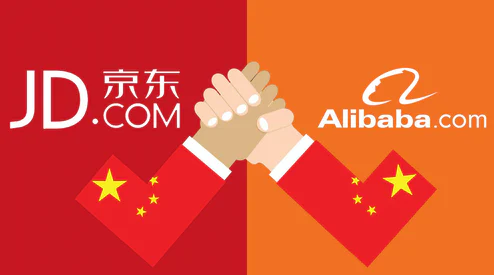On the surface, it seems like Alibaba is winning the Chinese e-commerce game. Alibaba’s platforms generate more than 3x the GMV JD does (1T$ vs 300B$ USD), their gross margins are almost 30% higher (44% vs 15%) and the traditional network effects of online marketplaces point to
Alibaba being the runaway winner in this game. But reality is far more nuanced, as JD’s relentless focus on customer service through quality and authenticated merchandise as well as a seamless logistics infrastructure has allowed them to compete against the mighty Alibaba, who
focuses on volume more than customer service.
chains. Retail shipping was historically inefficient in China and each inventory needed 7-8 movements from factory to customer. JD is reducing that movement substantially. This problem was particularly painful in rural areas, since
chains. Retail shipping was historically inefficient in China and each inventory needed 7-8 movements from factory to customer. JD is reducing that movement substantially. This problem was particularly painful in rural areas, since
products could see several levels of price mark-ups as they moved through many distribution layers. JD’s high efficiency retailing and transparent pricing helped farmers stop getting ripped off with fake and expensive seeds, fertilizers and other goods. JD offers just one layer
of distribution, solving what used to be several layers as the goods get to other cities. This competitive advantage had to be built brick by brick, in each city, as they went. Kathy Xu, the early JD investor, mentioned Richard Liu was building distribution centers in several
cities when there were just 20 orders in the entire city and the break-even for those centers was 2000. JD now owns its own warehouses and employs its own last-mile delivery personnel.
Alibaba is not as laser-focused on its supply chain as they are a marketplace first model.
Alibaba is not as laser-focused on its supply chain as they are a marketplace first model.
Within its Cainiao logistics platform, Alibaba does not have direct power and has 14 different third-party delivery partners. All its partners need to make a margin of profit. Alibaba has stakes in all its logistics partners but many are still owner controlled. This integration
via partnership is weaker than the deep vertical integration JD benefits from. The Covid-19 pandemic showed the power of JD’s integrated model, as they were the only player who mastered same-day delivery even in highly affected regions like Wuhan. The supply chain distinction
shows the focus JD has for its customers, as its self-operated logistics allow its users to benefit from reliable, fast and quality delivery services.
Alibaba started out as a digital marketplace, which does not own the inventory of the merchandise they sold. Their multiple has
Alibaba started out as a digital marketplace, which does not own the inventory of the merchandise they sold. Their multiple has
come down over the past few years (from 22x ev/sales at IPO in 2014 to 7x ev/sales today) as they have had to build out an inventory and supply chain infrastructure, which is eating at margins. They effectively went the exact opposite direction as Amazon, who started as a 1P
platform and is now growing its 3P platform. JD is going in a similar direction as Amazon, starting with an asset-heavy model by owning inventory and its own logistics network. JD was building its distribution centers at a time when even Amazon in the US was using FedEx and UPS.
The reason for this focus is that Richard Liu, CEO and founder of JD noticed early that 80% of customer complaints centered around delivery problems and so focused on building out warehouses in operating cities. Liu’s mission was simple: provide better services to customers,
delivering faster, with transparent pricing and authentic, quality goods and they’ll return. Compare this to Alibaba’s Taobao platform which is filled with inauthentic and low-quality goods. One of JD’s implementations was to build confidence and trust in e-commerce, such as by
the tracking of every sale in order to ensure quality and authenticity. This tracking also meant JD paid its fair share of taxes, which used to be unusual in China. Liu made difficult decisions even if others doubted him to accomplish his goals. The logistics system he built cost
1B$ in 2007, which would have bankrupted the company if it didn’t work out but Liu was convinced it was necessary to solve the problem of slow, late and damaged shipment of goods and to win customers over for the long term.
Liu catered to his deliverymen by paying them high
Liu catered to his deliverymen by paying them high
wages even if they were historically mistreated in China, since Liu realized they were the largest source of face to face interactions with customers, which could make or break the business. Liu spends one day per year doing deliveries to get a firsthand feel of the process. Liu
even makes sure that 70% of promotions are internal due in large part to great internal training through JD University because he is focused on fostering a solid internal culture.
(Richard Liu kissing one of his deliverymen's hands).
(Richard Liu kissing one of his deliverymen's hands).
Jack Ma at Alibaba preferred to be asset-light, with a focus on volume rather than delivery and customer service. And so JD benefited from a 3-year head-start. Their superior logistics network has born fruit consistently, and particularly during the Covid-19 pandemic.
The delivery to Wuhan accomplishment for JD was the result of years of incremental gains, such as through its 211 program, which commits JD to providing same day delivery for orders submitted to 11AM and next day delivery (before 3PM) for orders submitted before 11PM, which set
a new standard in China’s e-commerce sector. JD’s reputation is now entrenched, thanks to its quality assurance, authenticity and quick delivery.
Alibaba’s Cainiao model is more like a Visa or Mastercard network that sits on top of existing logistics providers everywhere. It can
Alibaba’s Cainiao model is more like a Visa or Mastercard network that sits on top of existing logistics providers everywhere. It can
scale quickly globally so that imported and exported goods by Alibaba can be done at large scale. This contrasts with JD’s more deliberate, localized supply chain model which prioritizes quick, efficient and personalized delivery.
Ultimately, Chinese e-commerce is a rising tide and has a long runway of growth thanks to increased penetration into lower tier cities, increasing consumer disposable income and saving and consumption trends, increasing Internet adoption rates and taking share from the brick
and mortar retail industry. In conclusion, it’s not a zero-sum game well and both Alibaba and JD will do well, as the TAM for Alibaba and JD is all of China retail.
here is the full write-up which includes a comparison and description of both BABA and JD, in better formatting https://secretcapital.substack.com/p/jd-and-alibaba-david-and-goliath
big thanks to @TanArrowz @EMparadigmshift @ShitFund @TidesAdvisors for helpful feedback & color on the region

 Read on Twitter
Read on Twitter



